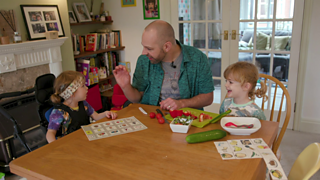Communication and Language
Key points and how to support CL
There are three aspects of Communication and Language;
- Listening and attention
- Understanding
- Speaking
Communication and language is a primary area of learning. This area is essential to your child's development as it is an important building block in reaching their full potential in every area.
Listening and attention
Listening and attention focuses on your child's ability to pay attention and stay focused. A example of a milestone for this area is listen to stories with increasing attention and recall.
Understanding
The understanding aspect of communication and language focuses on your child's understanding of what, where, how, who and why. An example of a milestone in this area is for your child to understand prepositions such as 'under' or 'next to'.
Speaking
Speaking milestones are used to gage your child's development with language. One of the earliest milestones for this is to lift their arms in anticipation to be picked up. This shows that your child knows how to communicate to you to get what they want. An example of a three year old's milestone is question why things happen and give explanations, e.g. who, what, where, why and how.
Home learning resources
Listening and attention
Aged 22-36 months
Encourage repetition, rhythm and rhyme by using tone and intonation as you tell, recite or sing stories, poems and rhymes from books. One handy support tool for this is to use puppets and other props to encourage listening and responding when singing a familiar song or reading from a story book.
Aged 30-50 months
Telephone game! (3+ players) Whisper something in your child's ear and ask them to whisper it to the next person. Once its gone all the way around every player, the last person says the word/phrase they heard. Let's see if you all heard the same thing! For younger children, stat with just a word and as they get used to the game you can increase it to a short sentence to make it more challenging!
Understanding
Aged 22-36 months
Use talk to describe what your child is doing by providing a running commentary, e.g. ‘Oh, I can see what you are doing. You have to put the milk in the cup first.’ Provide activities, such as cooking, where talk is used to anticipate or initiate what your child will be doing, e.g. “We need some eggs. Let’s see if we can find some in here.”
Aged 30-50 months
Jokes! A great way to enhance a child's understanding of humour is to tell them jokes! Throughout the day, tell your child appropriate jokes and explain it if needed. Turn it into a fun game with family, "If you don't laugh you win!" Check out the link below to see some jokes for children.
Speaking
Aged 2 and above
Create a scrapbook! Print out pictures of your child/children throughout the years including special events like birthdays and holidays. Create a scrapbook with them, put the pictures in order of earliest to latest and encourage them to talk about their experiences!
Website Links
Use the photo-links below to for extra ideas on how to further support your child with this area at home!
Help your child to sound out the letters with the link below!
We use Jolly Phonics to support younger children in pronunciation of different sounds and older children in connecting sounds to letters!



